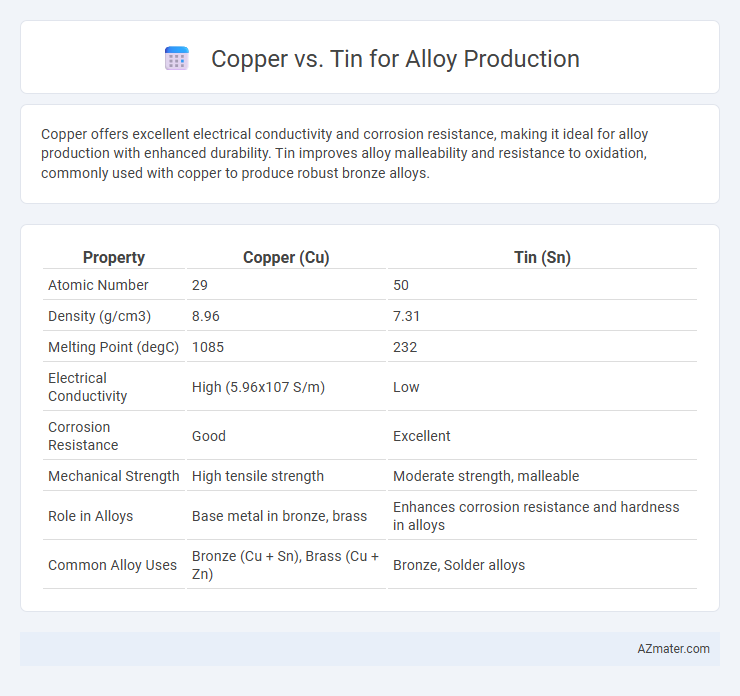Copper offers excellent electrical conductivity and corrosion resistance, making it ideal for alloy production with enhanced durability. Tin improves alloy malleability and resistance to oxidation, commonly used with copper to produce robust bronze alloys.
Table of Comparison
| Property | Copper (Cu) | Tin (Sn) |
|---|---|---|
| Atomic Number | 29 | 50 |
| Density (g/cm3) | 8.96 | 7.31 |
| Melting Point (degC) | 1085 | 232 |
| Electrical Conductivity | High (5.96x107 S/m) | Low |
| Corrosion Resistance | Good | Excellent |
| Mechanical Strength | High tensile strength | Moderate strength, malleable |
| Role in Alloys | Base metal in bronze, brass | Enhances corrosion resistance and hardness in alloys |
| Common Alloy Uses | Bronze (Cu + Sn), Brass (Cu + Zn) | Bronze, Solder alloys |
Introduction to Alloy Production
Copper and tin are fundamental metals in alloy production, primarily forming bronze, one of the earliest alloys used by human civilizations. Copper provides excellent electrical conductivity and corrosion resistance, while tin contributes hardness and improves the alloy's casting qualities. The combination of these metals enhances mechanical strength and durability, making copper-tin alloys ideal for tools, decorative objects, and industrial components.
Overview of Copper and Tin as Metals
Copper is a highly conductive metal known for its excellent electrical and thermal conductivity, corrosion resistance, and malleability, making it essential in alloy production such as bronze. Tin, a silvery metal with a low melting point, is prized for its ability to improve metal alloys by enhancing corrosion resistance and increasing strength without sacrificing ductility. Their combined properties in alloys result in materials with superior durability and versatility for applications in electronics, construction, and manufacturing.
Historical Significance in Metallurgy
Copper and tin have been crucial in alloy production since ancient times, with their combination forming bronze, a metal pivotal to the Bronze Age's technological advancements. Copper's malleability and corrosion resistance combined with tin's hardness enhanced tool durability and weapon effectiveness, accelerating societal progress. Archaeological findings highlight how early civilizations strategically sourced and alloyed these metals, shaping metallurgy's historical trajectory.
Physical and Chemical Properties Comparison
Copper offers superior electrical conductivity and thermal resistance compared to tin, making it essential for high-performance alloy applications. Tin, with its excellent corrosion resistance and low melting point, enhances alloy malleability and protects against oxidation. Combining copper and tin yields bronze, an alloy known for its hardness, durability, and resistance to wear and corrosion in marine and industrial environments.
Alloy Characteristics: Strength and Durability
Copper-based alloys exhibit superior strength and durability due to copper's excellent tensile properties and resistance to wear and corrosion. Tin, when alloyed with copper, primarily enhances the alloy's malleability and corrosion resistance but generally results in lower overall strength compared to pure copper alloys. The balance of copper and tin in alloys such as bronze determines their mechanical performance, with higher copper content typically providing greater durability and tin contributing to improved castability and resistance to environmental degradation.
Manufacturing Processes Involving Copper vs Tin
Copper's superior electrical conductivity and thermal properties make it a preferred metal in alloy production for manufacturing processes such as casting, extrusion, and rolling. Tin, used primarily in bronze alloys, enhances corrosion resistance and mechanical strength, critical in applications requiring durability and anti-friction properties. Manufacturing processes involving copper often require advanced melting and refining techniques to achieve purity, while tin alloys benefit from controlled cooling and solidification to optimize hardness and malleability.
Cost and Availability Analysis
Copper ranks higher in cost compared to tin due to its widespread industrial demand and limited mining sources. Tin exhibits greater availability with abundant reserves and lower extraction expenses, making it a cost-effective choice for alloy production. The balance between copper's higher durability and tin's affordability plays a crucial role in selecting materials for specific alloy applications.
Environmental Impact and Sustainability
Copper exhibits higher recyclability and lower environmental toxicity compared to tin, making it a more sustainable choice for alloy production. Tin mining often involves extensive habitat disruption and the use of hazardous chemicals, which can contribute to soil and water pollution. Copper alloys demonstrate greater longevity and energy efficiency in recycling processes, reducing overall environmental impact and supporting sustainable manufacturing practices.
Common Alloys: Bronze and Beyond
Copper and tin are the primary metals in bronze, an alloy known for its corrosion resistance and strength, with typical compositions ranging from 88% copper to 12% tin. Beyond bronze, copper combines with elements like zinc to form brass, offering enhanced machinability and acoustic properties, while tin's addition in small amounts improves solder and bearing alloys by increasing hardness and wear resistance. The choice between copper and tin in alloy production depends on desired characteristics such as tensile strength, corrosion resistance, and malleability, with bronze remaining a timeless example of their effective synergy.
Choosing the Right Metal for your Alloy Needs
Copper offers superior electrical conductivity and corrosion resistance, making it ideal for electrical and marine alloys, while tin enhances corrosion resistance and hardness when combined with copper in bronze alloys. Selecting the right metal depends on factors such as desired mechanical properties, environmental exposure, and cost-efficiency, as copper provides excellent thermal and electrical performance whereas tin improves wear resistance and machinability. For applications requiring durability and resistance to oxidation, a carefully balanced copper-tin alloy ensures optimal performance and longevity in diverse industrial applications.

Infographic: Copper vs Tin for Alloy Production
 azmater.com
azmater.com